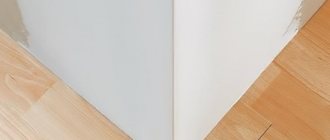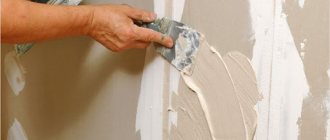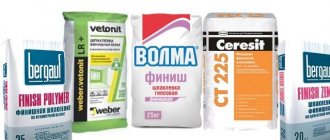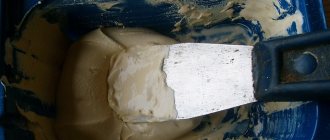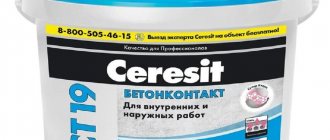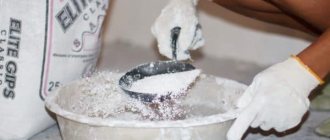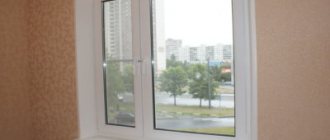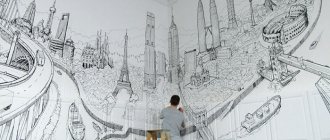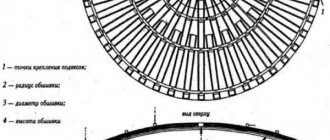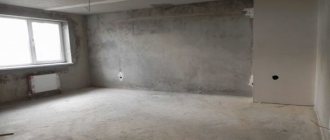Hello readers of my blog! Today we will talk about how to properly putty walls with your own hands. It would seem that the matter is not tricky, but when you are faced with this problem, you have to think about how to do it correctly, what preparation to do, what materials to choose. Thus, I decided that this article would be useful to someone, and I am devoting my efforts to this subject. In it I will answer a number of questions that will arise immediately before you properly putty the walls with your own hands, and some even after that. This topic is quite broad, because before work, thorough preparation is necessary, but how to do this? And this is a separate topic. You can learn about all this in great detail in the article below.
How to putty walls with your own hands
1. Gypsum putty is attractive at an inexpensive price, can be easily leveled, and does not shrink.
It has good heat and sound insulation, which is a significant advantage for apartments. In addition, this coating is fireproof. Bundex Tempo putty is used to level any surfaces and fill joints between gypsum board and gypsum fiber board sheets, without the use of reinforcing mesh in dry rooms.
2. Cement putties have excellent moisture resistance. Putties Bundex Layer and Bundex Finish are used for leveling surfaces of concrete and cement plasters in dry and wet rooms and facades of buildings and plinths.
3. Polymer putties. Important advantages include: excellent moisture resistance, do not shrink at all.
Using polymer putty, high quality treated wall surfaces are obtained. The price of such putty is slightly higher than cement putty.
DIY wall putty
The opinion that do-it-yourself puttying of walls is a rather complicated process for the average person who is not involved in construction or repairs can in some way be called erroneous.
In fact, if you want to try yourself in this matter, then you will probably succeed in the best possible way - the main thing is to know all the necessary subtleties and understand the basic principle of applying putty.
Do-it-yourself wall putty: preliminary leveling
The most important principle of puttying any surface is gradualism - you cannot take and eliminate all the unevenness of the walls or ceiling with one layer. With this approach to business, you can only ruin everything or waste money and time. The essence of leveling the surface with putty comes down to gradually filling first large and then smaller holes with a special gypsum solution.
To begin solving the question of how to level walls with putty, you need to start with large irregularities, to eliminate which a starting putty mixture is used. What is its advantage? It has a large grain size and allows you to apply it in a layer of up to 1 cm - and there is practically no chance that it will crack.
To apply the starting putty, you can use two tools - a spatula, which will be practical when the size of the distortions does not exceed its width, and also a plaster rule, which allows you to correct large distortions. Ideally, when applying starting putty to walls, it is better to use the rule - besides the fact that with its help you can level a fairly decent area of the wall with almost one movement, it also allows you to easily form internal corners.
To make it easier to solve the question of how to apply putty on a wall, it is better to start with a wide spatula, which is used to apply the putty and pre-level it.
After a significant part of the wall is covered with the required layer of starting mixture, it is leveled according to the rule. Don't forget to moisten with water.
After such preliminary leveling, the putty should be allowed to dry thoroughly - at least 12 hours. An indicator of incomplete drying of the putty mixture are wet spots. If they are not there, then you can proceed to the finishing putty of the walls.
Features of applying putty on walls with your own hands under wallpaper
Let's consider the question of how to properly putty walls under wallpaper. After applying and drying the finishing layer, the walls need to be checked for unevenness and minor flaws. If they are not eliminated, they will be clearly visible under the wallpaper.
It is easy to check the wall by applying a rule to it: if there are gaps, they are eliminated by applying a layer of putty. The spatula should be held at an angle of 25−30° relative to the wall. If you don’t know how to putty walls under wallpaper, you can choose a ready-made acrylic mixture and a medium façade spatula for this purpose. For final sanding of a dried wall, abrasive paper marked P-150, 180 is used.
Related article:
How to apply putty: finishing layer
Finishing putty on the walls will be much easier if the starting layer has been applied well. In this case, you will have to go over the surface, as they say, in a thin layer (thin layer) and fill the remaining small holes. The finishing putty must be applied in different directions.
This approach to the matter will immediately reveal all possible distortions - if protruding strips of mortar remain on the surface of the wall, then this is a sure sign of unevenness in this place. Don’t try to eliminate them at once - it won’t work anyway. Ideal putty on concrete or plasterboard walls can only be achieved by methodically and consistently applying two or even three layers of mortar.
Now let's understand such concepts as puttying walls under wallpaper for painting. Naturally, all the differences lie in the quality of the resulting surface.
Puttying walls for painting requires a more careful approach and, of course, high quality surfaces. If wallpaper allows scratches and even slight curvature of the surface, then you need an ideal wall for painting, since the paint will reveal even the most minor flaws in your work. That is why the final stage of leveling walls for painting is to strip the putty.
It is carried out after the walls have completely dried.
For these purposes, two tools are used - an electric vibration grinder or a hand block. With the help of power tools, work is completed faster and better. A special abrasive mesh of a certain grain size is installed on both the block and the grinding machine (grain number 150 is suitable for painting).
This mesh leaves virtually no scratches and at the same time gets the job done quite quickly. It should be understood that the larger the grain size of the abrasive mesh, the finer the processing. If we are talking about puttying walls under wallpaper, then a grid with number 100 or even 80 is quite suitable.
How to prepare walls
The ideal base for putty has sufficient strength and does not peel off. The wall is removed from the old coating: plaster, wallpaper, old putty underneath. Dirt and corrosive deposits are also removed. They also do not leave a loose structure.
A frozen or damp wall cannot be puttied. Sometimes they wait several days until the surfaces reach the required conditions. Then prepare the tools and means directly for applying the putty.
If necessary, the walls are treated with a degreasing agent. It is definitely worth using antifungal protection, because then it will be very difficult to fight the fungus. The cleaned wall is checked with a building level for vertical and horizontal deviations. A very large difference is puttied together with a reinforcing mesh. Noticeable depressions and irregularities are hidden within a few times. In one approach, different thicknesses of putty are applied depending on the material and purpose of the layer (starting, finishing).
Wall primer and its importance in the puttying process
The importance of primer in the puttying process is difficult to overestimate.
Probably, many of you have encountered such a problem as peeling putty during the process of dismantling old wallpaper, or worse - the appearance of bumps under the wallpaper. All this is precisely a consequence of ignoring the priming of the walls before putting them on. Applying a primer allows you to rid walls of dust, dirt and improve their ability to bond with putty - in professional slang this process is called increasing adhesion.
You need to primer always and everywhere when it comes to applying wet solutions or adhesives.
One thing should be understood - the walls are primed before applying the starting layer and in case you cleaned the putty.
In general, if we are talking about putty for painting, then after treating the walls with an abrasive mesh, they also need to be primed. As a rule, a standard deep penetration primer such as Ceresit CT17 is used for these purposes, but in some cases an antifungal primer and even a “Betonokontakt” primer can be used. The latter is used to increase the adhesion of walls painted with oil or nitro paint; the only condition for its use is that the old paint does not peel off.
How to properly sand walls after puttying
No matter how hard you try, after the finishing layer of putty, traces of a spatula will remain on the wall. If they are not removed, they will appear through the decorative coating. At the final stage you need to sand the surface. This is a labor-intensive task, but without sanding you will never achieve the desired result.
To work, you will need sanding paper with fine abrasive or a sanding mesh. Coarse sandpaper will leave deep scratches on the surface.
The material is fixed on a block and the walls are processed manually
To reduce dust, you can use the wet method - that is, lightly wet the surface. Hand movements when working with sandpaper are circular, the direction of work is from bottom to top.
The process can be mechanized using a grinding machine. How to use these tools in this video course:
Wall putty: how to properly prepare the necessary solution
A very important point regarding high-quality wall putty is the preparation of a gypsum solution - even the smallest lumps and random debris can turn the process of wall putty into a complete torture. To prepare putty, you need to follow three basic rules.
Cleanliness – not only the container for the finished putty should be clean, but also the mixer with which the mixing process is carried out.
You can forget about manually preparing putty, unless, of course, we are talking about a tiny amount of it. Correct proportions. You will have to determine them for yourself experimentally.
I will only say one thing: for walls with a large curvature it is better to use a thicker solution, and for minor leveling - a rare one (resembling thick sour cream, and not cream in which a spoon can stand). How to properly putty walls with your own hands
Kneading time. The putty is prepared for a long time and in several stages - first, the dry mixture is poured into the water and initial mixing is carried out. The goal is to get the entire mixture wet.
After this, the putty should be left alone for about five minutes (it should swell). After the specified time, the final kneading is carried out - it takes the same five minutes, only with short breaks. Stir for a minute, rest for a minute, stir again, and so on until you get a homogeneous mixture without lumps.
Now you know how to putty walls with your own hands.
And to conclude this topic, I would like to draw your attention to the fact that over time the putty hardens and becomes very thick. It can be diluted with water or re-mixed only if it is used to roughly seal large potholes or cracks. The fact is that after repeated stirring, lumps appear in the putty, leaving all kinds of patterns on the walls.
DIY wall putty
The old coating is removed and removed: wallpaper, paint, etc. Using a small spatula and a small amount of putty, all surface defects, such as cracks, holes from fasteners, bumps and depressions, are carefully eliminated. After the materials have dried, the surface is sealed and leveled using a trowel with an abrasive mesh attached to it.
The walls are then brushed and wiped with a damp cloth to remove any accumulated dust. After this, you can prime the surface using a spray gun or roller. The surface is dried for the time indicated on the primer packaging.
Preparation of putty (if it is not purchased ready-made).
The putty is prepared in accordance with the instructions on the packaging, observing the specified holding time.
Attention! You cannot add water or dry mixture to a ready-made composition. The consistency of the finished putty is determined by the manufacturer, and changing the proportions of the components can disrupt it, which will affect the final result.
The required amount of putty depends on the area of the surface to be treated. Approximate material consumption is indicated on the packaging.
It is convenient to apply the putty with a small spatula on a large one along its edge - so that it can be applied to the wall in one pass. The passage is carried out with a sweeping cross-shaped movement of the spatula with medium pressure until the mixture is removed from the spatula. The smaller the angle of inclination of the spatula, the thicker the layer.
At an inclination angle of about 30°, the layer thickness will be approximately 3 mm. Large influxes are removed. To apply putty in corners, it is convenient to use a corner spatula.
The applied layer of leveling material is dried under natural conditions, without allowing air flows (for example, from open windows or fans), for the time specified by the manufacturer. Sagging and unevenness are removed using a grater with an abrasive mesh attached to it. The flatness is checked by the rule, the bumps are polished, and the holes are marked with a marker and later (during finishing processing) leveled.
The surface is leveled again until the required evenness is achieved.
Before painting, an additional finishing layer of finely dispersed gypsum putty is applied. After drying, it is processed with a grater with an abrasive mesh. Before painting or wallpapering, use a fine-grain mesh No. 100–120.
How to properly putty a wall with your own hands
High-quality preparation of walls for various finishing works consists of obtaining a flat, smooth surface. To do this, you need to properly perform priming and puttying.
Puttying is not a difficult task. The main thing here is to follow the procedure and be able to handle construction tools correctly. We will look at how to properly putty walls yourself without resorting to the help of specialists in this article.
To putty the walls yourself, prepare a minimum set of tools. What tools can you not do without?
1. A drill equipped with a special attachment – a mixer. As a rule, putty is sold in the form of a dry mixture.
Water is added to this mixture in a certain proportion. Only with a special mixer can you mix the putty mixture perfectly. The output should be a homogeneous putty without lumps.
2. Set of spatulas. Be sure to choose a spatula of different sizes.
In your work you will have to use both large spatulas (40-50 cm) and very small ones. After all, in problem, hard-to-reach places, it will not be possible to properly putty the wall with a large spatula. This is exactly what small spatulas are used for.
3. Rollers and brushes for priming walls.
It is not advisable to skip the priming step. After priming, the wall is covered with a thin film. This not only further increases its strength, but also ensures excellent adhesion of the treated wall to any facing materials (adhesion).
4.Rule. It will be needed in case of uneven walls when you have to apply putty in a thick layer. To level thick layers of putty, it is convenient to use a long metal rule.
5. Alcohol or laser level. Often the wall surface is very uneven. Before starting the initial puttying, test beacons are installed using an alcohol or laser level to check.
6.Sandpaper. If you want to get a beautiful surface that is pleasant to look at, use fine sandpaper for rubbing.
For example, grouting with 240-grit sandpaper will allow you to get the perfect result. Use the finest sandpaper only when performing finishing putty. And at the stage of the initial initial putty, it is correct to rub the wall with coarse coarse sandpaper.
7.Manual skinner. Sanding will become much more convenient if you use a manual sander. This is a tool with special clamps on the handle for securing the skin.
8.And, of course, you can’t do without a container in which the putty is mixed.
What tool is needed for puttying?
To putty the walls yourself, prepare a minimum set of tools. What tools can you not do without?
1. Drill equipped with a special attachment - a mixer. As a rule, putty is sold in the form of a dry mixture. Water is added to this mixture in a certain proportion. Only with a special mixer can you mix the putty mixture perfectly. The output should be a homogeneous putty without lumps.
2. Set of spatulas . Be sure to choose a spatula of different sizes. In your work you will have to use both large spatulas (40-50 cm) and very small ones. After all, in problem, hard-to-reach places, it will not be possible to properly putty the wall with a large spatula. This is exactly what small spatulas are used for.
3. Rollers and brushes for priming walls . It is not advisable to skip the priming stage. After priming, the wall is covered with a thin film. This not only further increases its strength, but also ensures excellent adhesion of the treated wall to any facing materials (adhesion).
4. Rule . It will be needed in case of uneven walls when you have to apply putty in a thick layer. To level thick layers of putty, it is convenient to use a long metal rule.
5. Alcohol or laser level . Often the wall surface is very uneven. Before starting the initial puttying, test beacons are installed using an alcohol or laser level to check.
6. Sandpaper . If you want to get a beautiful surface that is pleasant to look at, use fine sandpaper for rubbing. For example, grouting with 240-grit sandpaper will allow you to get the perfect result. Use the finest sandpaper only when performing finishing putty. And at the stage of the initial initial putty, it is correct to rub the wall with coarse coarse sandpaper.
7. Manual skinner . Sanding will become much more convenient if you use a manual sander. This is a tool with special clamps on the handle for securing the skin.
8. And, of course, you can’t do without a container in which the putty is mixed.
List of tools that you may need when plastering walls. Photo — srbu.ru
Which putty is better to putty on walls and how to choose it
Classification of putties by composition: gypsum, polymer (acrylic) and cement.
Let's consider their disadvantages and advantages.
1. Gypsum putties are attractive at an inexpensive price, are easy to level, and do not shrink. The only drawback is poor resistance to moisture. Only this limits the scope of their use.
2. Cement putties have excellent moisture resistance, but have a significant drawback - a high degree of shrinkage.
3. And finally, polymer putties.
Undoubted advantages: excellent moisture resistance, do not shrink at all. Using polymer putty, high quality treated wall surfaces are obtained. The only drawback is the high price.
According to their purpose, putties can be divided into starting (leveling), decorative (finishing) and universal.
1. Characteristics of leveling (starting) mixtures: high strength, excellent adhesion, large grain size. Recommended: for leveling walls after applying plaster. Application thickness: 3 -20 mm.
2. For high-quality decorative finishing, it is advisable to apply finishing putties to the surface to be treated.
With their help, you can get a perfectly smooth, even surface, hiding small flaws. The strength of the finishing putty is less than the starting putty, its processing is not difficult. Apply in a small layer up to 4 mm.
3.Universal putties combine the properties of decorative and leveling mixtures. They cost more, although their properties are slightly inferior to finishing and starting coatings. We recommend using it when treating walls without large flaws.
The modern market offers dry and ready-to-use putties. The low cost of dry putty and the possibility of its long-term storage are attractive.
Ready-made putties are convenient to use. You don't have to use a mixer to prepare a homogeneous putty mixture.
This saves time and virtually eliminates dust. But ready-made putties are much more expensive than dry ones. Please note: such putties shrink greatly.
If a layer less than 2 mm thick is applied, ready-made putties cannot be used. They also do not boast a long shelf life. It is significantly less than dry construction mixtures.
Dry in bags and ready to use in a bucket of putty.
Expert advice: how to choose the right putty
In living rooms, studies, offices and other rooms with a normal level of humidity, budget gypsum putty is suitable. The bathroom is plastered with cement mixtures, and a little less often with acrylic mixtures. For finishing the facade, the most wear-resistant mixtures are selected.
Before painting, the walls are finished with polymer or gypsum putty. Drywall is treated with materials for dry rooms.
Sometimes both types of putty, starting and finishing, can be replaced with a universal one that combines their characteristics in terms of the size of inclusions and the characteristics of the binder. There are specialized mixtures for individual places. For example, only for joints, large cracks, etc.
The most popular options are polymer and gypsum plaster. Consumers like them for their ease of use and compatibility with almost all types of rough coating.
Preparing the wall surface for putty
The main thing is to make sure that the surface of the walls is absolutely clean. Be sure to remove stains of grease, paint or soot.
Of course, there should be no falling layers of plaster, residues of scale, wax or parts of the formwork. Don’t even start puttingty on frozen ceilings and walls. This is strictly not recommended.
Before applying putty, coat the walls with a primer. This will ensure good adhesion (connection) of the putty solution to the walls.
Prime the surface using a special roller. Try to apply the primer solution evenly, avoiding gaps. One layer is enough.
There are the following types of putty: finishing, lighthouse, starting. Let's look at the properties and scope of application in detail.
Puttying walls under wallpaper with your own hands: how to treat different surfaces
You already know which putty is best to putty on walls under wallpaper, now let’s look at the nuances of applying the composition to different surfaces.
Concrete walls
Due to the specific nature of the concrete surface, it is very difficult to achieve good adhesion: the material does not have sufficient hygroscopicity. Putty needs pores into which it can penetrate, and concrete has very few of them. Therefore, the application result may not be as expected.
The process takes place in several stages: removing the old coating, degreasing oil stains, cleaning the surface, expanding cracks on the plane, sealing defects with cement mortar.
A construction vacuum cleaner will remove dust, after which the surface will be primed twice.
Leave time to dry between each application.
Now you can mix the putty solution in proportions of 1:5. The composition is applied by casting and then spreading with a spatula. It is good if fiberglass or reinforcing mesh is used. This will prevent cracking of the dried coating.
After complete drying, another layer is applied, but the direction of movement of the spatula will be perpendicular to the previous one.
Dried surfaces must be sanded.
Brick surfaces
The brick surface also needs preparation: the old upholstery is removed, as is the cracked plaster, then the primer begins.
The brick wall is leveled with a grid map, special beacons are used
The mesh is nailed to the upper and lower corners with dowels or self-tapping screws, not reaching 3 cm from the wall itself. This will allow you to set the desired distance of the grid map from all ends.
First putty with the starting composition using a two-handed trowel and a large spatula. The trowel is held horizontally and the spatula vertically. Alignment is carried out using the trapezoidal rule.
The process is repeated until the layer of putty can no longer be removed by the rule
Then they work with the finishing composition, bringing the coating to perfection.
Wooden walls
The process of puttying wooden surfaces is not particularly different from other types. But wood, even a porous material, does not adhere well, so you will have to use a fixing sheathing or shingles.
For shingles, narrow slats are used, 3-5 mm thick and 15-20 mm wide. The length of the slats is 1-2 m.
The planks are nailed down, but without driving them in completely, they are bent
Two layers of sheathing (at 45º) with cells 45×45 cm² are sufficient. The second layer of shingles is filled with planks 15-20 mm wide and 5 mm thick. A chain-link mesh is suitable as a simpler method of sheathing.
After this, the normal puttying process begins.
The mixture is poured strictly at an angle of 45° on one side and the other - it is important that there are no voids left in the sheathing
Plasterboard putty under wallpaper
Let's look at how putty for drywall is applied. Puttying of smooth material is necessary due to its joints and fastening points. Therefore, it is necessary to apply an even layer of finishing putty, and then prime the wall.
Putty drywall is primed with special mixtures for this type of surface.
The screws are puttied using the cross-shaped method, the corners are pre-fixed to avoid chipping.
After the 1-2 mm layer has dried, sand the walls and work with a finishing solution the consistency of liquid sour cream. Now you can sand and remove dust from the surface.
Puttying corners
It remains to clarify how to putty the corners of the walls. The task is not difficult if the layer of plaster is even. If there are unevenness in the starting layer, then proceed as follows.
- First, plaster the corners with a decent layer of mortar, then putty them with a wide spatula. A wide spatula is placed against the corner, the mixture is removed onto it and the spatula is removed. Movements are carried out either from top to bottom or from bottom to top.
- First of all, they work with one side of the corner, and when it dries, they move on to the second. Here you need to sand the surfaces before puttying. But if the joints are poorly sealed, or the work was done with 150-200 grade plaster, then this method is not suitable.
- The corners are leveled with the finishing solution, but not all at once. You will have to work like this 3-5 times.
First, process one side of the corner, then move on to the second.
Starting surface putty
Putty is performed using coarse starting material.
It's not difficult to find. When purchased, it is called “starting putty.” To remove large differences in walls, to hide grooves and holes, this putty is convenient to use.
The thickness of a layer of such putty applied at a time can reach 1.5 cm. Allow the previous layers to dry completely. Only then proceed to applying the next layer of putty.
In order to obtain the highest possible quality of putty surfaces, a special painting mesh is installed on the wall, and the putty is distributed evenly over the entire surface. In this case, the walls are completely covered with putty.
The advantage of this technology is that when using a painting mesh, the putty fits perfectly onto the surface of the walls. And the surface itself becomes stronger and smoother. Moreover, the coarser the painting mesh, the smoother the treated wall surface.
Starting wall putty.
Leveling corners with putty
In order to make an even corner using putty, you need to take a plaster or painting corner profile, which is usually glued before applying the first layer of plaster itself. But this method may not be the best for further painting. In order to solve this problem, you can use another option - just leave more plaster on the corners, and after drying, sand this material thoroughly with sandpaper.
In principle, this is all you need to know when plastering walls. The most important thing is to understand how to do everything correctly, and, of course, try your hand. If you do everything according to the technology of applying and working with putty, then you can expect excellent results. Below is a video example from the program “World of Repair”
Lighthouse wall putty
The materials are no different from the starting putty.
The only difference is that beacons are used. A lighthouse is a wooden, plaster or metal strip, which is set strictly vertically, checking the verticality with a level. The beacons are attached to the walls using some kind of gypsum mixture; it dries quickly, after which you can proceed directly to puttying.
The same applies to alignment along horizontal lines. In this case, a rule will come in handy for leveling the putty layer. By following these recommendations, after starting work, a flat surface is obtained.
To ensure the quality of the work, you can check it with a level. This type of finishing is used quite rarely.
Reason: its cost is significantly higher than the starting putty, although visually they are almost the same.
Choosing spatulas for puttying walls and leveling corners
We select a spatula with an even, rectilinear shape of the blade, and it is desirable that it be long. Any other proportions will have a bad effect on the quality of the application, so you will have to make a lot of additional movements and correct defects. We also pay attention to its flexibility - it should not give in under slight effort. We also look at the wave (bend) of the canvas: a slight curvature is normal, but the defect will be visible to the naked eye. Even expensive spatulas have excessive curvature. Stainless steel is considered the best material for the blade.
Pay attention to the spatula handle. A good pen has the following parameters:
- short length;
- convenient structure;
- rigidity.
To work with corners, you should purchase an angle spatula. It is made in the form of 2 square/rectangular planes connected at right angles. We buy 2 models at once: for internal and external corners.
Final wall putty
After completing the starting or lighthouse putty, proceed to the finishing putty. It is done with finishing putty mixtures. It is this putty that gives the wall surfaces perfect smoothness.
The smallest cracks or pores are eliminated. It is important that the finishing putty completely coincides in plane with the previously prepared surface, so it must be applied in a very small layer. If the starting or final putty is done poorly, you will not be able to correct the situation with the finishing putty.
Therefore, first try to make the surfaces of the walls perfectly smooth. Only then proceed with the finishing putty. Its main goal is a beautiful smooth wall surface.
The finishing putty is carried out under special lighting, this allows you to see the smallest irregularities. Photo – vipconstruction.kiev.ua
Puttying cracks in walls
To hide cracks in the walls, we recommend using gypsum mixtures for putty. The material santegypsum is much more elastic in work, but hardens much longer. Advice from competent specialists: at first it is recommended to slightly widen the crack, slightly increase its depth and thickness.
To increase the roughness, you can scratch it with a knife or other sharp object along its entire length. Then carefully treat it with a primer. Only after this should you begin to putty.
Preparation of putty
How to properly putty walls with your own hands
If you purchase a dry mixture, it must first be prepared before application. To do this, you need to pour water into a bucket and pour the mixture into it. Typically, detailed preparation instructions are found on the packaging with the material. To stir the mixture, you will need a drill with an attachment. The result should be a homogeneous substance, not too thick, but not liquid either. There is no need to make a lot of the mixture at once, since it hardens quite quickly and becomes unsuitable for further use; it would be better to dilute several portions as needed. After all work is completed, you will need to wash the container and tools. The remains of the dry mixture can be stored, wrapped in film; you need to choose a cool, dry place for storage. If you bought a ready-made mixture in a bucket, you can leave it for storage by filling it with water.
How to apply putty on walls
1. If you use dry putty, you need to properly prepare the putty mixture.
Cooking sequence:
Please note: the readiness of the putty should be determined by consistency. It should become elastic and stick slightly to the spatula. If the putty mixture flows, it means it is runny.
Add dry mixture little by little to correct the situation. If there are clumps in the putty, it means the putty is too dry. Add water little by little, stirring thoroughly to achieve perfect homogeneity.
2.Apply starting putty. It is convenient to use a large spatula. Apply the putty in medium portions, spreading evenly over the surface.
Hold the spatula at an angle of about 30 degrees. The putty is applied diagonally in one motion. Recommendation: to avoid transitions and bumps, each subsequent layer should be applied overlapping.
Attention: when making the starting layer, mix the putty in small portions.
This will avoid the appearance of dried-out dry particles, which will reduce the quality of work. Don't be too alarmed by unsightly stripes from the spatula. The stripes are perfectly hidden with finishing putty.
3. To process smooth corners, we recommend using a corner spatula.
Working technology: first, using a small spatula, apply a small layer of putty along the entire height of the corner or slope. Then carefully level the surface with an angle spatula. The putty layer should dry well within 24 hours.
To putty corners you will need a special corner spatula.
4.Once the starting putty has completely dried, proceed to the finishing putty. A large and a small spatula are used for work.
Using a small spatula, apply putty in small portions onto a large spatula. Then apply the putty mixture evenly to the surface. The layer thickness is about 1.5 - 2 mm.
5.Before you putty on a wall for painting or wallpaper, wait until the previous layers have completely dried.
The starting and first layers of finishing putty must be completely dry. This approximately takes about 12 hours. Then you can apply the finishing putty.
6.After complete drying, proceed to final sanding with sandpaper.
Attention: before applying each next layer of putty, it is advisable to treat the previous one with a primer.
Layer of putty application
Which layer of putty needs to be applied to the wall depends on the type (method) of wall finishing: rough or finishing .
- Rough finish . The main difference in the composition is the size of the filler. Here the fraction can be 2.5-4.5 mm. That is, when applying a single-layer solution, a coating thickness of +0.5 mm (3-5 mm) is acceptable. This material is used to partially level the surface with minor differences and defects. When applying two layers, the use of reinforcing agents is mandatory. It can be mesh or fiberglass. The last solution is added according to the manufacturer's instructions.
- Finishing. Here, due to the small fraction of the mineral component, the permissible layer of putty does not exceed 2 mm. The coating is smooth and continuous with a high degree of strength. The latter indicator is higher for ready-made polymer-based pastes. The use of this putty is to finish smoothing the surface. More often, the work is performed before subsequent painting or application of liquid wallpaper or Venetian plaster (decorative).
In order for the mixed putty solution to be conveniently applied to the walls, its consistency should be moderately thick and plastic
How to putty walls for painting and wallpaper
The walls are first leveled using several layers of putty.
If the wallpaper is thick, it is advisable to apply putty in two layers. When using thin wallpaper, we recommend applying three leveling layers of putty.
This will allow you to paste the wallpaper on a flat surface without wrinkles or bubbles.
Painting walls requires more careful preparation. The paint does not hide even the slightest unevenness. Therefore, to level the walls, it is necessary to use finishing putty.
Well, now it's time to finish the article. All the material I wanted to share has been reviewed. I hope it will be useful to you, and you will use it if necessary, how to properly putty walls. Improve your own practical skills and gain new knowledge, as they say: “It’s never too late to learn!” That's all, thank you for your attention, successful and easy repair!
Sanding and priming walls after puttying before painting
The layer of dried putty must be sanded so that the surface becomes smooth. The amount of work is influenced by the skill of the finisher. The better the composition is applied, the easier it will be to process the walls.
Light sanding is used between coats of putty to better even out the finish. The last layer requires thorough processing. An abrasive mesh is used for grinding. It is attached to a block or grater. A coarse mesh is suitable for intermediate layers, and a fine mesh for the last layer.
The quality of laying and sanding the putty is checked with a lamp or spotlight, directing the light at the wall from different angles to identify defects. Up to 6 coats of finishing putty can be applied if necessary.
A smooth surface must be treated with a primer 1-2 times using a brush or roller. Then you should start painting the prepared base.

